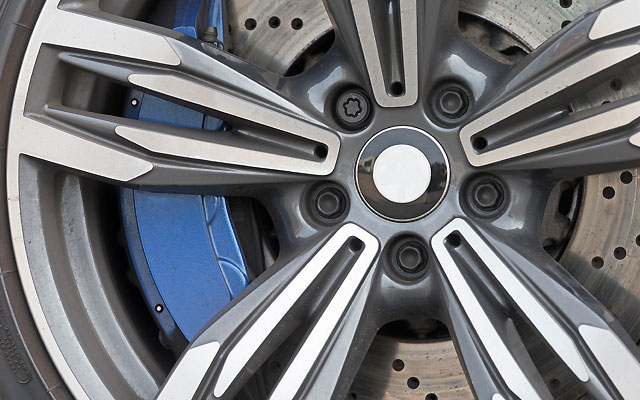Long gone are the days when you’d have to pump your brake pedal so your car didn’t skid when braking. The anti-lock braking system (ABS) has made driving safer for years and is installed in all modern cars.
You’ve probably heard of it, but do you know exactly what ABS is and how it works? Find out how your car’s ABS improves your driving and what to do if there’s a problem with your brakes.
What are anti-lock brakes?
Anti-lock brakes (also known as ABS) are a safety system equipped as standard on most new vehicles. They’re designed to stop your car from skidding when you brake sharply.
If a car is travelling at speed when the driver brakes hard, the wheels could lock. This can cause the car to lose traction and the driver to lose control of the steering. ABS makes this less likely to happen, as it automatically detects when a wheel is about to lock and ‘pumps the brakes’, so to speak, applying and releasing the brakes in rapid succession so that traction is maintained with the tyres and the road surface. This pulsating action allows drivers to maintain control in an emergency braking situation.
How do anti-lock brakes work?
The wheel hubs of a car with ABS each have a sensor which can tell how quickly each wheel is rotating and the rate of acceleration and deceleration. It’s often part of the car’s system of Electronic Stability Control (ESC). Not all cars with ABS have this system, but you can’t have ESC without anti-lock brakes.
When the driver brakes sharply, ABS works by sensing when the wheels are about to lock. It then rapidly reduces and increases the braking pressure multiple times per second, applying the optimum pressure.
This allows the wheels to keep moving as the car slows down, instead of locking up. It gives the driver more control over steering and makes the car less likely to skid.
What are the components in the anti-lock braking system?
The ABS is made up of 4 main components:
- Speed sensors – These warn the system when a wheel is about to lock up
- Valves – These control how much pressures is in each brake line and can relieve pressure if it’s too high
- Pump – If a valve releases pressure in the brake line, the pump can increase the pressure again
- Controller – This is a computer in the car which monitors the speed sensors and controls the valves
When do anti-lock brakes take effect?
ABS brakes don’t kick in when braking gently under normal conditions – they also might not operate at speeds below 15 mph. They’ll only kick in when braking sharply, for example if a driver is forced to perform an emergency stop.
You may remember being asked to perform an emergency stop when learning to drive or during your driving test. When performed correctly, the driver feels the brake “judder” which is the ABS kicking in as the brakes rapidly engage and release.
If brake problems cause a breakdown, we’ll rescue you.
How to use anti-lock brakes
To use anti-lock brakes properly, you should do the following:
- Press firmly on the brake pedal and maintain pressure – you don’t need to pump the brakes yourself
- If done correctly, you’ll feel the brake pedal vibrating or ‘pulsating’. Don’t let this feeling distract you, keep maintaining pressure on the brake pedal
- Keep two hands on the steering wheel and steer calmly in the direction you want to go, avoiding jerky or fast movements
- Keep applying pressure to the brake pedal until you come to a stop
Remember – ABS is just a safety feature. You still need to drive carefully and maintain control of the vehicle. ABS doesn’t change your stopping distance, but it can help you to maintain control of your vehicle in an emergency situation.
Do you pump your brakes with anti-lock brakes?
An anti-lock braking system works by rapidly pumping the brakes automatically when it senses that your wheels are about to lock up. So no, you don’t need to manually pump the brakes when stopping your vehicle if it has an ABS system.
What does it feel like when ABS triggers?
If you brake hard enough to trigger the ABS system, you’ll likely feel some form of feedback through your vehicle, including rapid vibrating from the brake pedal along with a grinding noise. Both the vibrating and the grinding is caused by the ABS system rapidly engaging and releasing the brakes. When ABS is activated it may also feel like the brake pedal is pushing back towards you.
How are ABS brakes different to regular brakes?
Essentially, ABS brakes ensure that the wheels won’t lock up when a vehicle needs to come to a quick stop. Regular brakes don’t have this safety feature, meaning the wheels can lock up (making skidding much more likely).
With regular brakes, hydraulic pressure is applied to the brake pads to bring the car to a stop. umping the brakes’ or cadence braking is required when braking heavily in a vehicle with no ABS in order to stop the wheels from locking up. To pump the brakes, fully press the brake pedal down until you feel the pressure, then quickly release the brake pedal and push it fully down again – repeat this process until you stop the vehicle.
Additionally, ABS brakes are more technically complex and need to be checked for calibration regularly (every 30,000 to 40,000 miles, or every 4 years).
When are anti-lock brakes most effective?
ABS is most effective on dry, solid road surfaces. It helps the driver to brake as quickly as possible while maintaining control of the vehicle. But the system can increase overall stopping distances as it continually releases the brake for tiny intervals.
On slippery conditions like snow and ice, or unstable road surfaces like gravel, anti-lock brakes might not be as effective.
How do I know if my car has anti-lock brakes?
The easiest way to find out if your car has anti-lock brakes is to check the dashboard. Vehicles that are fitted with an ABS system should have an ABS warning light. It’s easy to recognise as the symbol for an anti-lock brakes warning features the letters ‘ABS’ inside a circle.
Alternatively, you can check your vehicle owner’s manual, contact the manufacturer of your vehicle or the dealership that you purchased it from, or you can check under the hood for a sticker that indicates whether your vehicle has ABS.
Is ABS better or worse than traditional brakes?
ABS systems might be better than traditional brakes as they add a layer of safety to your driving experience, helping you to maintain control of your vehicle in an emergency braking situation. Your tyres shouldn’t lock up with ABS, but it’s very much possible to lock up with traditional brakes.
Which type of braking system is better also depends on the driving conditions. For example, ABS brakes work better in wet and slippery conditions, but perform less well on dry and roads with good traction.
You may find that ABS brake repairs are more expensive than traditional brakes, as they’re more complex, so if saving money is your primary concern, then traditional brakes might be preferable.
What are the limitations of ABS brakes?
Anti-lock brakes are an important safety feature in modern vehicles, but they do have some drawbacks:
- Anti-lock brakes may not work perfectly on loose road surfaces, like sand or gravel, as they struggle to maintain traction between the wheels and the ground while stopping
- ABS brakes work well on wet slippery roads, but not on ice, as the wheels are still prone to locking up on icy surfaces
- They can help you to maintain control when braking in an emergency, but they won’t help with handling, cornering and acceleration
- They can cost a lot more than traditional brakes to repair
- As an ABS system is a combination of hardware (sensors, control modules, hydraulic pumps etc.) and software (the programming that controls the system), any malfunction could be disastrous as it could remove your ability to brake in an emergency
What does the ABS warning light mean?

If any part of the anti-lock braking system isn't working as it should, the ABS warning light will come on. You can check your vehicle handbook to find out which warning light this is and what it means.
If the ABS light comes on it means that the anti-lock brake system isn’t activated. This can affect other systems like stability control and traction control, if your car has them. You’ll also fail your MOT if the ABS light is on.
It’s usually still safe to drive your vehicle when the ABS light comes on, as long as you don’t hear any strange noises from the wheels. But you should take your car to a mechanic as soon as possible to check out the problem.
If you hear any strange noises or are unsure, you can call us out to a breakdown.
What should you do if your anti-lock brakes (ABS) warning light stays on?
If you start your car and the ABS warning light stays on after you’ve started driving, you should make sure to get your car checked by a mechanic ASAP. When the warning light stays on, it indicates that there could be a problem with the braking system in your vehicle, meaning you might not be able to brake safely. It’s important to resolve the issue promptly.
Why do people turn off their ABS system?
People shouldn’t turn off their ABS system during normal driving, but some will do it in very specific situations. For example, off-road driving might be easier for an experienced driver if they’re in complete control of the brakes. When the ABS system is on during off-road driving, it can make the wheels spin and lose traction.
Is it an MOT failure when ABS system doesn’t work?
Yes, it’s an MOT failure when the ABS system is faulty. There are several parts of the ABS system, each of which can result in a failure if they’re faulty. At an MOT, the tester will check the sensors, hydraulic pump, control module and the brake lines. If the ABS warning light stays on when the engine is started, this will also lead to an MOT fail.

